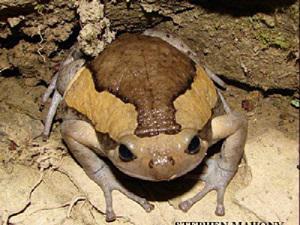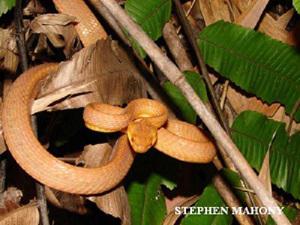Stephen Mahony
This project aims to document as many species as possible of herpetofauna that occur in Tripura in order to know the true biological importance of this otherwise data deficient state.

Kaloula pulchra. Asian Painted Bullfrog from the Jampui Hills, north-east Tripura.
Approximately half of the state of Tripura is considered to be under forest cover and it is located in a currently recognised biodiversity hotspot region. Despite this important status the states' potentially rich herpetofaunal biodiversity has so far been almost totally neglected by the scientific community. Currently a very under-representative 39 species of herpetofauna are reported in literature from Tripura. During a 7 day visit to one locality in eastern Tripura during 2006, I found an additional 12 species (Mahony, in review) of which, at least one, a frog, appears to represent a presently undescribed species and a further five species require additional research for a definitive identification.

Boiga ochracea. Brown Cat-eyed Snake a mildly venomous species from Jampui Hills, north-east Tripura.
The purpose of my proposed research is to carry out the first intensive surveys of several sites, including natural areas and anthropogenically modified habitats. The aim is to identify exactly which species are present in order to better understand distribution patterns and habitat niches of the various species. Additionally, I plan to create awareness primarily in the areas and villages where I work, among the local communities regarding the benefits of preserving their local biodiversity, the importance of Amphibia for the control of crop pests and aiding in regulating mosquito numbers which are of primary concern in this area due to the ongoing problems of mosquito borne diseases such as malaria, and dengue fever. Amphibia have also been internationally recognised as a keystone species in the assessment of the health of the local environments.
Also, unfortunately due to traditional belief's and superstition, snakes in many areas are generally killed on sight from fear of being venomous. Understandably, as the actual venomous species have not yet been identified in the this remote state, I hope to be able to identify as many as possible. This information, along with promotional information regarding the benefits (again as pest control) of non-venomous species will also be relayed to the local communities in an effort to create further awareness.